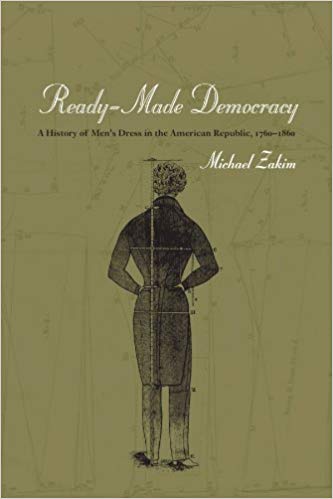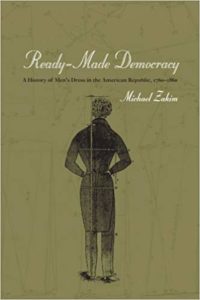Refashioning the Republic

Michael Zakim, Ready-Made Democracy: A History of Men’s Dress in the American Republic, 1760-1860. Chicago: The University of Chicago Press, 2003. 296 pp.
“Clothes make the man.” In Ready-Made Democracy, Michael Zakim offers a new variation on this sartorial dictum: men’s dress comprises the social order, or at least it did in antebellum America. By his account, the advent of ready-made clothing represented not just a change in male fashion but the triumph of democratic capitalism over the republican ideals and patriarchal practices of the Founders. To be sure, in the 1850s boosters still celebrated the simplicity of American costume in proud opposition to the decadent extravagance of Europe. By then, however, American simplicity entailed the mass consumption of mass-produced commodities, not the virtuous self-abnegation of the Revolutionary generation. The ideological continuity of political discourse belied a fundamental restructuring of American society and culture.
Zakim frames his study as an intervention in the longstanding debate among American historians over whether the United States was born liberal or, alternatively, became liberal after starting out as something else. Forty-five years ago Carl Degler wrote that “capitalism came [to America] in the first ships,” but since the late 1960s scholars associated with the republican synthesis have highlighted America’s premodern, precapitalist, and preliberal roots. Zakim finds their portrait of colonial America convincing. But he also suggests that too much emphasis on America’s preliberal past has diverted attention from the Big Story: the “great transformation” of the United States into a democratic capitalist society in the early nineteenth century. It is this Big Story that Zakim seeks to illuminate in Ready-Made Democracy. He succeeds brilliantly.
Zakim begins his narrative with the patriots’ embrace of homespun as a symbolic and practical weapon in the widening protests against imperial policy during the 1760s-70s. Americans, he suggests, were sufficiently enmeshed in the Atlantic market to make nonimportation of British goods a real test of American virtue at home and of American buying power abroad. Yet they were still sufficiently engaged in household production that they could pass such a test, at least in the short term. Meanwhile, the Revolutionary elite’s public commitment to homespun affirmed bonds of commonality with the people at large, producing what Zakim terms a “consciously leveling moment” that permanently transformed American society (21).
Washington’s well-publicized decision to wear a suit made of American cloth to his presidential inauguration in 1789 confirmed the association of domestic manufacture and republican independence. Yet Zakim observes that “domestic manufacture” took on new meaning as textile factories supplemented and then displaced the household production of cloth in the United States from the late eighteenth century forward. Whereas during the Revolutionary era wearing American-made clothes signified frugality and private sacrifice for the public good, by the mid-nineteenth century wearing American-made clothes signified prosperity and the rapid growth of the nation’s internal commerce and industrial capacity. To the extent that homespun still carried with it symbolic power in the antebellum era, it was as a nostalgic critique of increasingly dominant liberal values.
Zakim devotes the middle chapters of his book to changes in the organization of the men’s clothing industry in nineteenth-century America, especially New York City. He traces the rise of urban clothiers who organized networks of production and distribution that converted manufactured fabrics into a wide variety and large quantity of ready-made garments for sale to local consumers on a retail basis and to middlemen nationwide on a wholesale basis. Compared to entrepreneurs in many other industries, clothiers required relatively little start-up capital, but they had to respond deftly to market signals because they operated on very thin margins. For clothiers and customers alike, Zakim suggests, the market increasingly appeared as an autonomous source of power over which they had little personal control.
Alongside the clothier there emerged the custom tailor, commonly portrayed as the representative of craft tradition but in truth, according to Zakim, a capitalist par excellence. While custom tailors sold individually fitted suits and other personalized apparel, they increasingly rationalized the production process in order to reduce basic costs. The result was a series of strikes by journeymen tailors in the 1820s and 1830s and the subsequent introduction of standardized “drafting systems” to simplify the task of cutting patterns to the right size for a particular customer. “[I]n the new conditions of capitalism,” Zakim explains, “a personalized fit, one that started from measurements taken directly by a tailor, was no less based on the systemization of the buying public . . . than was the ready-made” (94).
The democratic implications of these “new conditions of capitalism” were manifested in the dress code of young male clerks in the mid-nineteenth-century metropolis. As “modestly waged market bureaucrats,” clerks did not actually produce anything of substance but they helped administer financial and commercial enterprises essential to an industrializing economy (110). Zakim views them as key pioneers of modernity, and he interprets the respectable uniformity of their business attire (three-piece suits complemented by shirts with replaceable white collars) as indicative of the bourgeois imperative to reconcile “ambition and self-control”–or alternatively, “individuation and standardization”–in service to capitalist growth and sober citizenship (123, 125).
While Zakim highlights the tendency of market dynamics to undermine traditional modes of hierarchical authority, he understands Marx too well to mistake democratic capitalism for a truly egalitarian social order. Surveying the collective experience of workers who made the clothes worn by clerks and other fashionable American men, he portrays a gendered process of proletarianization that encompassed both journeymen performing skilled labor in prestigious tailoring establishments and seamstresses doing mundane outwork in overcrowded tenement buildings. The “suffering seamstress became a symbol of the times,” he tells us, because employers and consumers felt deep ambivalence toward wage-earning women (162). To address the problem of female poverty, middle-class reformers advocated pity rather than better pay since a living wage would raise production costs and undermine the bourgeois ideal of separate spheres and dependent womanhood. The old patriarchy of household production had been dismantled, but a new form of capitalist patriarchy arose in its place. Zakim argues that the popular perception of seamstresses resorting to prostitution to make ends meet had profound implications: “This directed protest away from class to gender–or, as Nancy Armstrong has observed, the political problems inherent in industrial relations were turned into a sex scandal” (172).
Toward the end of Ready-Made Democracy, Zakim turns his attention to the contribution of men’s dress to the civic and political culture of antebellum America. Evaluating fashion’s role in transforming the social order, he writes, “Its ability to elicit voluntary compliance–to bring an individual to eagerly forfeit some of his hallowed independence in order to join the reigning mode–made fashion a form of governance: a system of majority rule for a polity that located sovereignty in the will of every citizen” (187-88). “[P]rivate behavior,” he adds, “could no longer be mandated by public decree since fashioning one’s self had since become a natural right, not to mention a condition of the ‘free’ market. The post-utopian commonwealth had consequently to be constructed on the principle of popular emulation” (190).
Tocqueville could not have said it better. Indeed, part of what makes Ready-Made Democracy so worth reading is Zakim’s beautiful, even elegant, prose. At least as important is his ability to marry Marxian analysis and Tocquevillian insights into a coherent and compelling interpretation of American history from the late eighteenth through the mid-nineteenth centuries. For Zakim, the Big Story is not only the rise of an industrial social order rooted in the capitalist exploitation of wage labor and the bourgeois fetishism of commodities. Nor is it simply the decline of deference to elite rule and the rise of individualism, majoritarianism, and equalitarianism. The Big Story is how all of these developments unfolded together without American society falling apart–except, of course, during the five years when clerks and millions of other Americans dispensed with their civilian clothes and donned military uniforms to fight the nation’s horrifically bloody Civil War.
This article originally appeared in issue 4.4 (July, 2004).
Gary J. Kornblith teaches American history at Oberlin College. His most recent publication is “Rethinking the Coming of the Civil War: A Counterfactual Exercise,” which appeared in the June 2003 issue of the Journal of American History.
